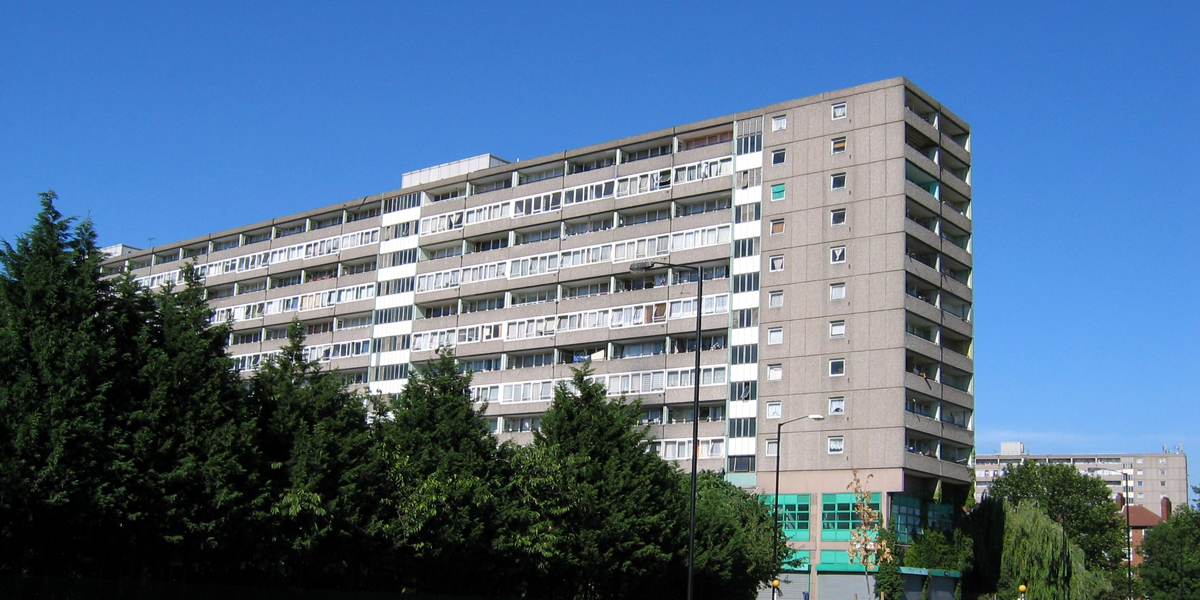The blame game
Poor places are not responsible for their own poverty and nor do the people who live there cause their own stigmatisation, argues Stephen Crossley “Certain milieus gather reputations for moral inferiority, squalor, violence, and social pathology, and consequently they objectify the...
Poor places are not responsible for their own poverty and nor do the people who live there cause their own stigmatisation, argues Stephen Crossley
“Certain milieus gather reputations for moral inferiority, squalor, violence, and social pathology, and consequently they objectify the fantasy of the dreadful enclosure… According to the stereotype, housing projects are loci in which sick and dangerous people drift together in a kind of behavioural sink, producing urban capsules of pathology so highly concentrated that the ordinary resources of the body social cannot control them.” E.V. Walter, 1977
Politicians, and those with political aspirations, have often sought to demonstrate their concern about poor neighbourhoods by visiting them. The historian Seth Koven notes that when William Beveridge first arrived at Toynbee Hall, one of the university settlements in the East End of London, ‘he felt like ‘an American tourist doing Whitechapel in two days’. In the United States in the spring of 1964, the then president, Lyndon Johnson, embarked on a series of ‘poverty tours’ as part of America’s ‘all-out war’ on human poverty and unemployment. More recently, politically motivated visits to, or discussions about, disadvantaged and impoverished neighbourhoods have often been suffused with attempts to localise the causes of some of the problems faced by residents of those areas.
When Tony Blair was elected prime minister in 1997, he chose the Aylesbury estate in Southwark, London, as the setting for his first speech. Built in the 1960s and 1970s, the Aylesbury replaced older Victorian housing that was considered no longer fit for purpose. The estate featured elevated walkways – ‘streets in the sky’ – and the early residents loved their new properties, although this did not last. Blair was unequivocal as to why he had chosen the estate as the setting for his speech, arguing that the estate, and places like it, had been ‘forgotten’ by the previous government. He spoke of the ‘fatalism’ on the estate, and ‘the dead weight of low expectations, the crushing belief that things cannot get better’ that needed to be addressed if the estate and, by extension the country, was to improve and succeed. The implication was clear: people on the Aylesbury estate had given up and this lack of aspiration and hope was, as much as anything else, the reason for their poverty.
Blair talked of an ‘underclass… cut off from society’s mainstream’. Although the speech was delivered to residents of the estate, it was very much addressed to the wider electorate, with the location providing the perfect site to articulate the divisions Blair perceived in British society. Denying the residents of the Aylesbury Estate the right to define themselves, Blair called them ‘forgotten people’, made them appear ‘Other’, and brought them to the attention of the mainstream majority, to whom he was determined to ‘reconnect’ them. His speech made no mention of the lack of any evidence that supported the ‘underclass’ thesis, and the robust refutation of the concept by British social scientists at regular intervals from the 1930s onwards.
In 2002, the then leader of the Conservative party, Iain Duncan Smith, travelled to Easterhouse estate in Glasgow in an attempt to demonstrate that he wanted to ‘listen and learn’ from the people that Blair had accused the Tories of ‘forgetting’. His visit was referred to as the ‘Easterhouse epiphany’ by the Scottish newspaper the Herald, and Duncan Smith himself later admitted that it was ‘a sort of Damascene point’.
Subsequent visits to Easterhouse and other parts of the East End of Glasgow helped to bring Duncan Smith back from the land of the political dead following his disastrous spell as Conservative leader. It was during these visits that he allegedly discovered his ‘passion for social justice’. Once again, the setting was more than just a backdrop for a politician attempting to mark himself out as a champion of and for the poor. The Daily Telegraph noted, in keeping with the ‘forgotten people’ discourse, that ‘IDS went to streets that had seen few Tories in recent years, to find out what causes poverty and how to put it right’. Following a promise he made to Janis Dobbie, a woman he met in Easterhouse, whose son had just died after a heroin overdose, Duncan Smith established the Centre for Social Justice (CSJ) think tank. His frequent visits helped ensure that Easterhouse and other parts of east Glasgow became strongly associated with the concept of a dysfunctional and broken society that the CSJ propagated.
Duncan Smith himself stated that it was going to Glasgow that helped him realise the scale of the problems that society faced and, indeed, what had caused them:
Standing in the middle of an estate like Easterhouse, you know it was built after the war for a purpose, only to see this wrecked and dreadful set-up today, with families locked into generational breakdown, poverty, drug addiction and so on. And that really does confront you with the thought that we did this – we built the brave new world, and look where it’s gone.
More recently, in January 2016, whilst he was still prime minister, David Cameron launched an initiative to rid Britain of its “sink estates” as part of his attempt to ‘wage an all-out assault on poverty and disadvantage’. He said he wanted to ‘really get to grips with the deep social problems – the blocked opportunity, poor parenting, addiction and mental health problems’, adding:
There’s one issue that brings together many of these social problems… It’s our housing estates. Some of them, especially those built just after the war, are actually entrenching poverty in Britain – isolating and entrapping many of our families and communities.
Echoing Blair nearly 20 years earlier, he went on to argue that these estates were ‘cut off, self-governing and divorced from the mainstream’. Cameron’s announcement was met with immediate criticism for, as one architect put it, heralding in ‘a new era of blaming buildings – rather than government welfare policy – for the socio-economic challenges facing many impoverished communities’. Essentially, it ‘conflated the causes of poverty with the layout of a communal stairwell’. Author Lynsey Hanley argued that Cameron’s position attempted to turn cause and effect on their heads, and ‘flaunts a refusal to look at the complex situations of marginalised people, not least why some people are cast, through policy and perception, to the margins in the first place’.
All of these interventions by high-profile politicians are good examples of the neighbourhood effects thesis, which argues that where you live affects your life chances. Harald Bauder, who authored an influential and critical paper on neighbourhood effects in 2002, argued that: ‘The idea of neighbourhood effects suggests that the demographic context of poor neighbourhoods instils ‘dysfunctional’ norms, values and behaviours into individuals and triggers a cycle of social pathology and poverty that few residents escape.’
Neighbourhood effects studies claim to demonstrate that place matters when it comes to addressing social issues. These studies have been influential on both sides of the Atlantic partly because, as Tom Slater of Edinburgh University points out in a trenchant critique of the concept: ‘it is seductively simple and, on the surface, very convincing’. Focusing on problems caused in and by ‘problem areas’ is also politically expedient for politicians attempting to distract attention away from the shortcomings or unintended consequences of their own policies. Indeed, as Slater argues, the neighbourhood effects theory is an ‘instrument of accusation, a veiled form of class antagonism that conveniently has no place for any concern over what happens outside the very neighbourhoods under scrutiny’.
Stigmatised spaces thus appear to take on a life of their own, able to entrench poverty and attract disadvantage. Residents are portrayed as members of a homogeneous underclass, and the reality of neighbourhoods as contested, heterogeneous, socially constructed spaces gets glossed over by this simplistic narrative. Such myths also deflect attention away from the external forces that largely determine the conditions in which people live.
Families in places such as Easterhouse and the Aylesbury estate are not responsible for housing policy, nor do they decide macro-economic policy, wage levels or education systems or structures. Residents do not make decisions about the levels of support offered via what is supposed to be a system of social security, nor do they have much influence over the levels of funding available to local public services. People living in poor neighbourhoods do not even have much say over how they are talked about or treated by such services and other organisations and institutions. They generally do not generate their own stigmatisation. The ‘taint of place’ that is often attached to working-class neighbourhoods comes from how they are represented in media and political discourses.
Decisions about resources and services that could be made available to neighbourhoods and their residents are often taken hundreds of miles away, perhaps by people whose only experience or knowledge of poverty might have been gleaned from a carefully managed day trip or two. It is worth remembering that relatively few of the politicians who voted through, or abstained during, the welfare reforms introduced in the UK since 2010, were going to be substantially affected by them, or could imagine what they might mean to the many families already living on low incomes across the country. Once people living in a poorer neighbourhood are perceived to be responsible for that locale’s deprivation then you are likely to get misplaced attempts to help or, worse, policies of disinvestment, with damaging and harmful consequences.
Economic geographers working at the Centre for Regional Economic and Social Research at Sheffield Hallam University have demonstrated various ‘Westminster effects’ on disadvantaged neighbourhoods by highlighting how the government’s recent welfare reforms have had disproportionately greater impact upon poorer areas. In a similar vein, researchers at the Institute for Fiscal Studies have demonstrated that it is poorer local authorities that lost most money from central government changes to local government spending and revenue allocation.
Indeed, in December 2016, the Department for Education announced a new funding formula for schools that would see funding shift from many schools in poorer, urban areas to often more affluent rural areas in the south and east of England. More recently, the shocking tragedy at Grenfell Tower has highlighted attempts, in one of the richest local authority areas of the country, by councillors, officials and contractors to minimise costs when refurbishing the tower.
It is vital to acknowledge that where people live can significantly affect their lives, and also to understand the local effects of national policies. Notwithstanding this, a compelling case can be made that the strongest effects, both symbolic and material, exerted on residents of disadvantaged neighbourhoods in the UK most often emanate from the words and actions of politicians in Westminster, rather than emerging out of concrete walkways.
Dr Stephen Crossley’s book In Their Place: The Imagined Geographies of Poverty, published by Pluto Press, is out now

